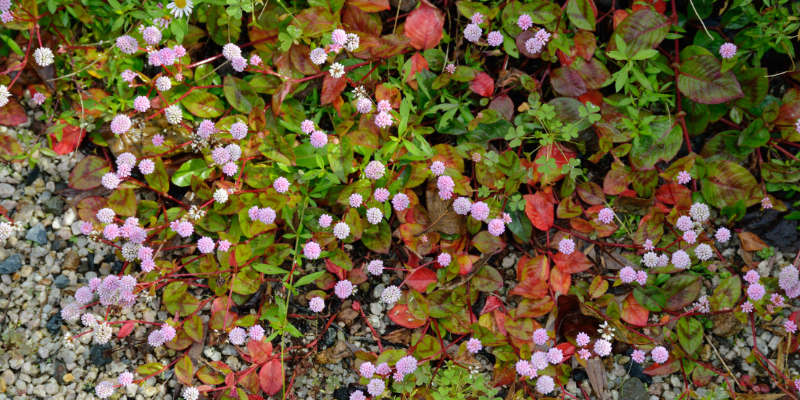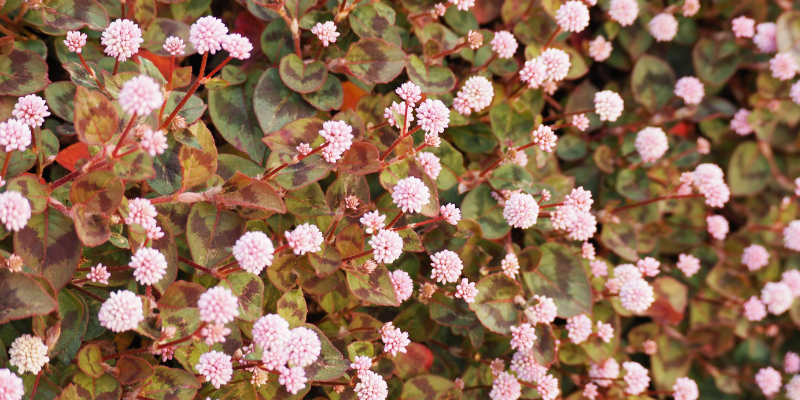We’ve had a lot of people contacting our free identification service to ask about a pink coloured Japanese knotweed that they’ve seen on their property or in their garden. But what is this mysterious plant?
Read on to find out.
What is Pink knotweed?
Knotweed comes in many shapes and forms. Many of the requests received in our identification inbox turn out (thankfully) to be a harmless plant species. These look-a-likes give people quite a scare and they’re relieved to find out that it wasn’t the dreaded Japanese knotweed.
Pink knotweed is another member of the knotweed family – however, unlike some its harmless cousins, Pink knotweed is classed as an invasive species here in the UK and as a noxious weed in the southwestern US states.
This species of knotweed is known for spreading quickly and forming a dense mat of foliage that prevents the growth of native species, making it a threat to biodiversity.
Originally adapted to withstand cold conditions in mountainous areas, Pink knotweed now prefers damp and swampy areas, but it is a very hearty weed and can thrive pretty much wherever it finds itself growing including dry and sandy soil.
Interestingly, Pink knotweed is a highly adaptable species. It can reproduce both sexually and vegetatively, it is tolerant to drought, it can be both perennial and annual (meaning that it can bloom just once, or it can bloom every year) and it can become an evergreen species in warmer climates where its leaves will sustain it all year round.

Is it Pink knotweed?
Identifying this plant can be easy once you know what to look for. Though it is a cousin to Japanese knotweed, Pink knotweed has some very distinct characteristics:
Characteristics
- Tends to only grow to around 6 inches in height (15cm)
- Can grow horizontally to around 5 feet (1.5m)
- Prefers wet ground, but will thrive anywhere including dry and sandy soil
- Forms a dense mat of foliage over the ground
- Is said to have a strong urine-scented odour
Leaves
- Lance-shaped from 2 to 11 inches long. Typically longer leaves indicates that it is perennial
- Dark red edges and burgundy chevrons on the leaf face
- Grow on red stems that root at the nodes
- Can be evergreen in warmer areas and can sustain the plant all year long
Flowers
- Pom-pom flowers that are about 2 inches long start from spring and die out in winter
- Depending on the strain, may bloom once, or may bloom every year
- Flowers cluster in globe-shaped spikes above the foliage

How does pink knotweed spread?
As a highly adaptable species it can spread both sexually and vegetatively giving it a variety of methods to spread depending on the climate and habitat that it finds itself in.
Like its cousin, Japanese knotweed, Pink knotweed reproduces vegetatively through its roots and rhizomes and will spread by extending its roots and then forming new shoots – one of the reasons it’s so resilient. Like Japanese knotweed, even small amounts of root remain in the ground, the plant can regrow and continue to spread.
Pink knotweed tends to be a ground-covering plant and if left untreated can start to infest the land, its dense mats will form over large areas pushing out native plants.
How can you get rid of pink knotweed?
Eradicating Pink knotweed isn’t as simple as just pulling up the roots or using some weedkiller on it. This plant is highly resilient, has an extensive root system and as we mentioned, it can grow from small amounts of root that is left in the soil.
To remove Pink knotweed, we would recommend one of two options:
With excavation, it is possible to have specialists dig out the contaminated soil and remove it to a registered landfill location, providing a permanent solution. It’s important to work with skilled contractors on this as they will need to be able to identify the rhizomes underground and will need special licences to carry the waste materials.
Another option is to control the infestation with a herbicide treatment plan. Using herbicides will kill off the visible above ground growth and prevent it from spreading further.
Wrapping it up
So, there you have it. Pink knotweed de-mystified! If you have any questions or suspect you may have Pink knotweed on your property, don’t hesitate to get in touch with our environmental experts who will be more than happy to help you with our free identification service.
Until next time!

